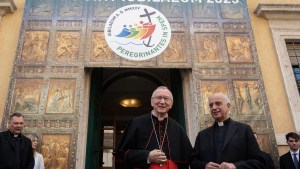On December 24, Pope Francis opened the first Holy Door in St. Peter’s Basilica, inaugurating the Jubilee. This door, bearing 15 bas-relief panels recounting the story of man’s redemption, is the most symbolic, marking the launch of the Jubilees since the year 1500.
Rome also offers four other holy doors: those of the three other major basilicas (St. John Lateran, St. Mary Major, St. Paul Outside the Walls) and a door opened by the Pope in the Rebibbia prison, as a special sign of attention to the inmates.
“There are five Holy Doors, and they are only in Rome,” Davide Emanuele Nappi, communications officer for the Dicastery for Evangelization — which is organizing the Jubilee — tells Aleteia. The doors are in fact designated in the papal Bull of Indiction of the Jubilee, and “ bishops do not have the power to institute them.”
In the history of ordinary Jubilees, Holy Doors have always been reserved for Rome. Only the Jubilee of Mercy in 2016 — an extraordinary event — established the possibility of establishing Holy Doors in the dioceses.
This year, therefore, there are no Holy Doors outside Rome, which remains the Jubilee city par excellence. This is borne out by the extensive work carried out by the municipality in recent months to prepare for the millions of pilgrims who will symbolically pass through the Holy Doors of the Eternal City.
Indulgence granted worldwide
On the other hand, while coming to Rome to visit the tombs of the apostles is “a sign of proximity to the center of Christianity,” explains the dicastery spokesman, a multitude of other jubilee sites are associated with the holy year. There is no need to travel long distances to obtain the jubilee indulgence, which is granted equally in Papua New Guinea, Liechtenstein, and the polar circles.
As a sign of the Church’s determination to spread mercy widely, any shrine, basilica, cathedral, chapel, or other church designated by a bishop or by an episcopal conference as a jubilee site is an eligible destination for obtaining the indulgence. Such is the abundance of these sites that the dicastery has decided not to list them.
Among these places are such curiosities as the chapel — actually the aft deck — of the Amerigo Vespucci, the Italian navy’s sail training ship, declared a “jubilee church” by the Military Ordinariate of the Peninsula. The Armed Forces Diocese has also designated the church of the Celio military hospital, and the chapel of the Santa Maria Capua Vetere prison — which has a department for drug addicts.
In the United States, the website of the USCCB points to the official page of Catholic shrines for pilgrimage sites in many states where people can obtain the Jubilee Indulgence.
Learn about indulgences with our Primer: part one and part two.
Conditions for obtaining an indulgence
According to the Catholic faith, a plenary indulgence obtains the remission of all of the temporal punishment due to past sins. This means that a person who dies after receiving a plenary indulgence and before committing any further sins does not spend any time in Purgatory before going to heaven. Such indulgences are granted to the baptized who meet certain prerequisites. These include going to confession, attending Mass, and praying for the Pope’s intentions, and being detached from all sin, even venial.
In addition to these basic requirements, to obtain the Jubilee indulgence the faithful should make a pilgrimage to a jubilee site. However, those unable to travel are not excluded. For example, nuns or monks living in a cloister, the elderly, and the sick can pray from home, and follow a Mass celebrated by the Pope or their bishop on a screen or radio.
It’s also possible to obtain a plenary indulgence by performing a work of mercy and penance (in addition to the basic requirements). The Vatican asks that you abstain for at least one day from “futile distractions” or “superfluous consumption,” or do a good deed for the poor, or an activity that defends life “in all its stages.”
Technically, the indulgence can be obtained once a day, and it is possible to apply it to a deceased person.
In addition to Rome, other major pilgrimages are offered by the Church, notably to one of the three basilicas in the Holy Land: the Holy Sepulchre in Jerusalem, the Nativity in Bethlehem, and the Annunciation in Nazareth. These too have no Holy Door, but have the advantage of being built in the land of Jesus.




